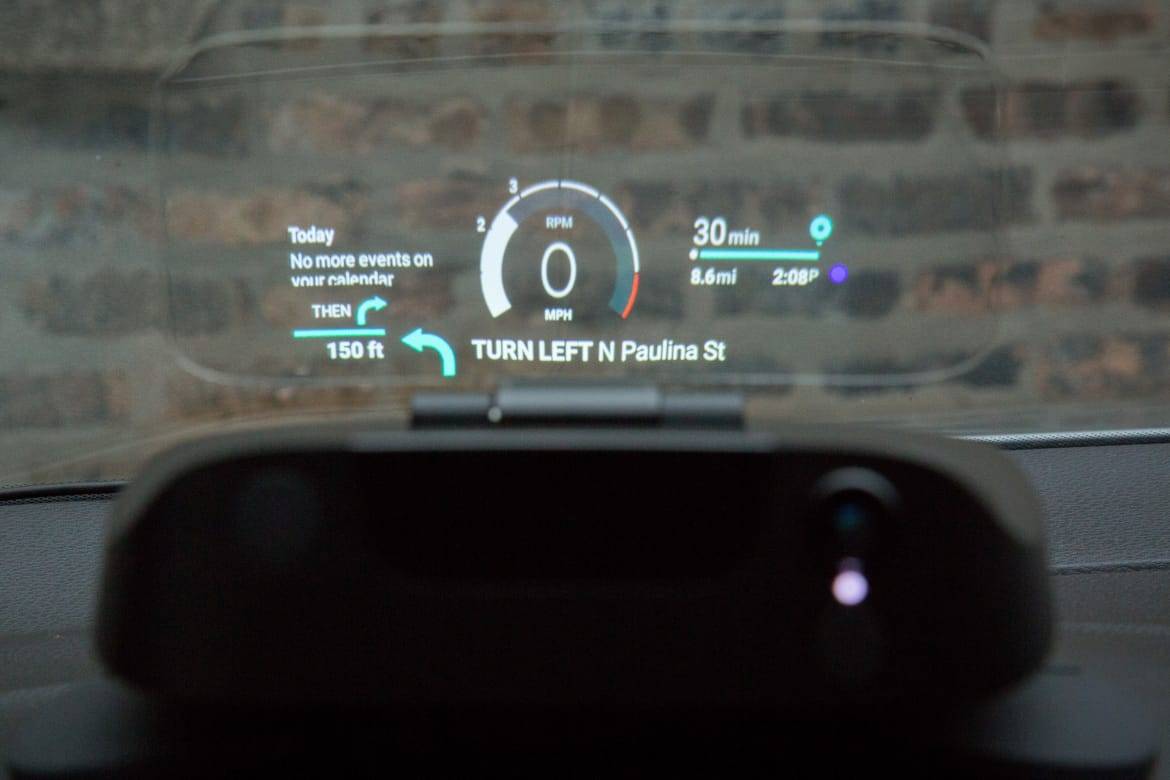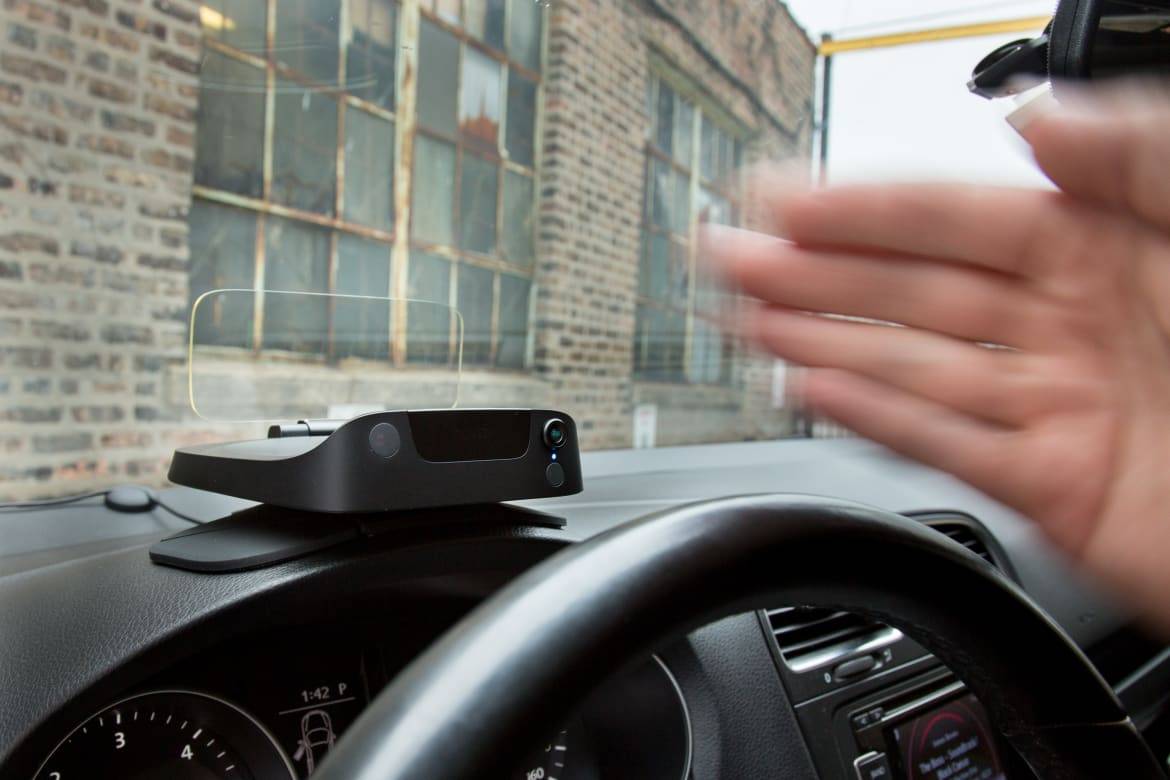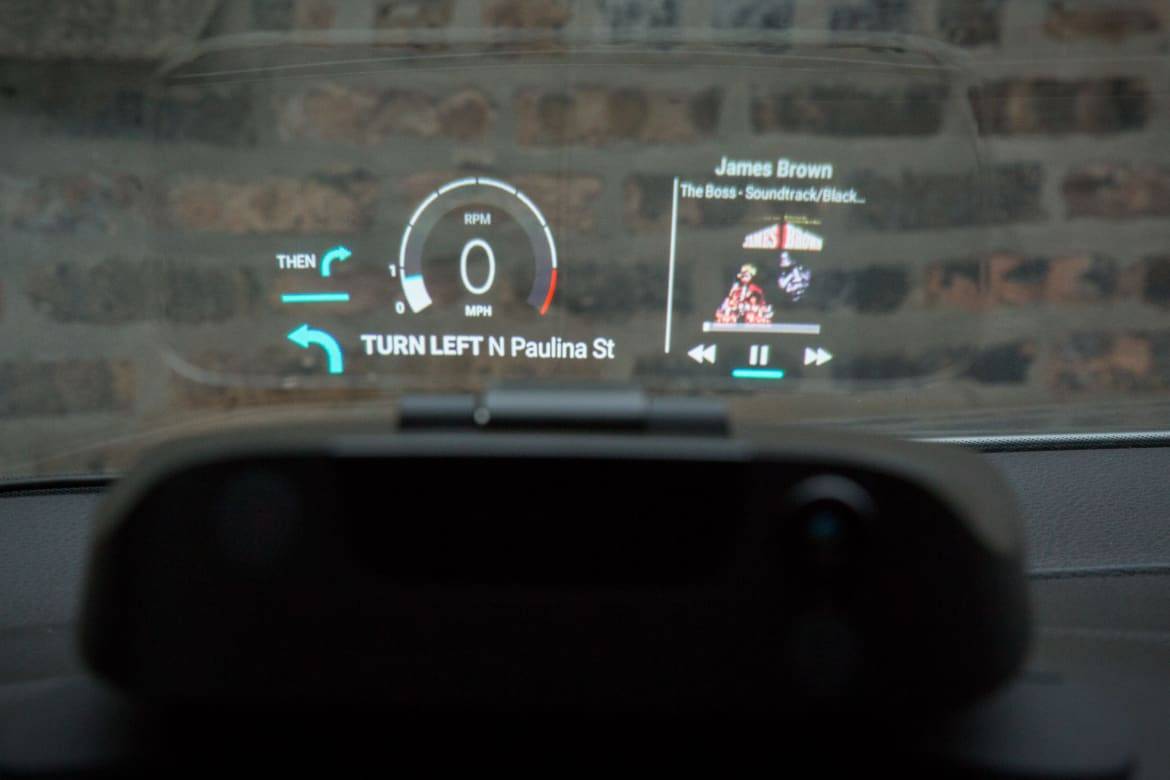Navdy Head-Up Display Review


CARS.COM — The original developers of head-up display technology for military fighter jets probably never thought their tech would be available for installation in a Volkswagen diesel wagon with 66,000 miles on the odometer. Thanks to aftermarket head-up display manufacturer Navdy, however, it is, and we installed the $599 self-contained head-up display in our long-term 2013 Volkswagen Jetta SportWagen TDI test car to see how this aftermarket alternative compares with factory displays.
Related: Navdy Rethinks Head-Up Display
Navdy is more than an expensive device that sits on the dashboard displaying vehicle speed in front of your face. The product is billed as a safer way to use your phone while driving by pairing with a smartphone to show navigation, notifications for texts, email and social networks plus music on the pop-up lens. Navdy also uses gesture control (like newer BMWs) to accept or reject calls and messages by swiping a hand in front of the unit. It would be an understatement to say there’s a lot going on in this little device.

Installation
A complimentary installation service is offered in select cities, including Cars.com’s home base of Chicago, but we wanted to get our hands dirty. Navdy installs in a breeze with minimal effort, so my fingernails remained dirt free. The Navdy mount is secured to the dashboard via an adhesive pad, which houses the connector/magnetic mount that the unit slips into to gain power and data for the whole kit and caboodle.
A single cable runs from the connector/mount to the onboard diagnostic port, or OBD II, on 1996 and newer vehicles that communicates engine and vehicle speed, fuel consumption and fuel-level data displayed on the lens. The cable neatly tucked into the crevasses of our VW’s dashboard for a clean installation.

The last part of the installation is mounting the Bluetooth-powered thumbwheel to the steering wheel, which is another no-brainer, no-tool-needed install. The thumbwheel is the main controller for scrolling between on-screen Navdy menus, and it firmly secures to the steering wheel.
Next up is setting up the angle of the lens for optimal viewing; only the road should be viewable through the lens, and the body of Navdy shouldn’t block any part of the road, which gave us a little trouble. I’m 6 feet tall with long legs and the seat had to be adjusted so high to see only the road through the lens that the top of my head brushed up against the Volkswagen’s ceiling. How far you have to adjust will vary by the shape of your dashboard and body.

Apple CarPlay/Android Auto Alternative?
Navdy shares aspirations with Apple CarPlay and Android Auto in making phone interactions hands free while driving. Navdy connects to your phone through Bluetooth and the Navdy iOS or Android application and then, using a Bluetooth connection with the car, allows music, navigation directions, calls, messages and even emails (if you choose) to be read through the car’s speakers.
When I received a text from my wife, for example, her picture from my phone contact showed up in the Navdy display, and then I had the option of using hand gestures to swipe one way to have the message read over the stereo or swipe the other way to ignore (the answer in this case is to always swipe to read). Responding to texts isn’t as easy as Apple CarPlay, however. Rather than CarPlay’s immediate prompt to respond, Navdy facilitates access to Siri or Google Now by requiring you to hold the thumbwheel button to respond. Navdy also can show lines of text from the message, though I prefer the default setting of read aloud only.

Users can choose which notifications are displayed within the Navdy app, including email, text messages, Facebook, Facebook Messenger, Twitter and others. Having my email linked resulted in notification overload that quickly cluttered the screen with pop-ups, so I reserved notifications for texts and calls.
Music is also controllable through Navdy using the thumbwheel. A double tap of the thumbwheel button brings up music from your phone with basic controls of pause, play and skip tracks through the thumbwheel. Navdy doesn’t have a main menu with various apps like CarPlay, so you have to rely on Siri to change music sources, or pick up your phone and open another app.

As a Navigation System
The navigation function is as good as any portable GPS. It’s easy to see upcoming turns and the map is smartly laid out, which made navigating around downtown Chicago easy. Even switching menus to the main speedometer keeps important navigation prompts in prominent view. Time-to-destination and distance-to-destination estimates are clearly displayed.
New destinations are entered through the Navdy application, and recent and favorite destinations are stored within the Navdy menu accessible via the thumbwheel. Searching for a destination is done through Google Maps, though guidance is powered by location services company Here, according to a Navdy spokesperson. Navdy currently doesn’t work with Apple Maps, Waze or other navigation apps. Even without those big-name navigation apps, I didn’t observe any glaring problems or think “Why would it take me that way?!?!” while navigating familiar city roads.

As a Head-Up Display
To start, Navdy is less like a traditional head-up display because of its crystal-clear resolution and more like a fully formed multimedia screen typically reserved for a vehicle’s center dashboard. Contact pictures, album covers and navigation maps pop up in stunning clarity for a head-up display.
The digital speedometer is easy to read, and the tachometer stretches around the outside, showing engine speed. The tachometer reading is a bit delayed, though, so it’s not as useful for performance-car applications as the factory head-up tachometer in a 2017 Chevrolet Corvette, for example. Becoming acclimated to the Navdy head-up display only took an hour or so before I was completely comfortable with the system.
While head-up displays sound like a luxury car feature, they are and have been available on inexpensive cars for roughly three decades now. Even a 2017 Mazda3 can be equipped with a head-up display from the factory. The head-up display in my old 2000 Pontiac Grand Prix was one of the only things that didn’t break after driving the car for a decade. But if your car didn’t come with a head-up display from the factory, you didn’t have many options until now.
Navdy has blown me away showing what’s possible from an aftermarket device because it doesn’t feel like an aftermarket accessory. It unfortunately looks like one since it’s slapped on the dashboard with an adhesive pad. I don’t mind seeing this sitting on top of a Volkswagen Jetta, but I would hesitate before installing one on a more stylish and expensive vehicle.
Personal styling preference aside, Navdy is feature packed and now, at $599 (down from $799), more accessible than when launched; Navdy was on sale for $499 at time of publishing. Not many cars are configurable with Apple CarPlay or Android Auto and a head-up display from the factory, but among those on the lower end are the Chevrolet Camaro, Buick LaCrosse, Cadillac ATS, Audi A4 and BMW 3 Series. Navdy is a surprisingly capable assistant that isn’t intrusive or difficult to install. Compared with the wireless backup camera we removed to install Navdy (both require the diagnostic port, and the backup camera costs $479.99), Navdy would be my pick to keep around.

Managing Editor Joe Bruzek’s 22 years of automotive experience doesn’t count the lifelong obsession that started as a kid admiring his dad’s 1964 Chevrolet Corvette — and continues to this day. Joe’s been an automotive journalist with Cars.com for 16 years, writing shopper-focused car reviews, news and research content. As Managing Editor, one of his favorite areas of focus is helping shoppers understand electric cars and how to determine whether going electric is right for them. In his free time, Joe maintains a love-hate relationship with his 1998 Pontiac Firebird Trans Am that he wishes would fix itself. LinkedIn: https://www.linkedin.com/in/joe-bruzek-2699b41b/
Featured stories




